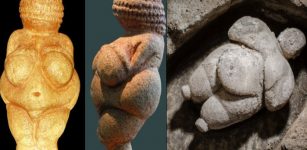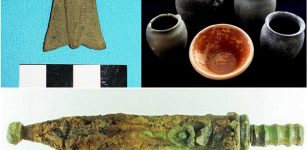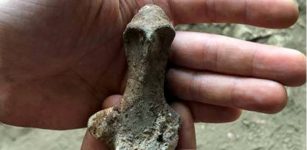Skegriedösen (Skegrie Dolmen) – 5,000-Year-Old Stone Chamber Tomb In Southern Sweden
A. Sutherland - AncientPages.com - Megalithic graves appeared more or less simultaneously in southern Sweden and were first used around 3500–3300 cal BC.
Image credit: Jorchr - CC BY-SA 3.0
Sweden has only about a hundred dolmens compared to other countries, mainly in Skåne, Halland, and Bohuslän. From the beginning, Sweden certainly possessed many more of them. Today, the existing number of these structures constitutes only a tiny part of what once existed.
No one knows precisely how these massive stones were moved and laid in their place.
Today, we visit Skegriedösen (Skegrie Dolmen) in Skegrie Parish in Trelleborg, Skåne, Sweden's most southern county. This dolmen (in Swedish - 'dös') is a stone chamber grave from the Neolithic times.
What we see today are the large boulders. All organic building materials such as reeds, birch bark, cloth, animal skins, and wood have disappeared over time.
The tombs built by the Neolithic people must have made a powerful impression once they were completed. They were then covered with smaller stones and soil like a hill. Over time, new soil layers have raised the ground level, and parts of the megalith have been hidden underground.
In the Nordic countries, a dolmen was the oldest form of a megalithic tomb. "Farmers colonized southern Scandinavia in 300-400 years from around 4000 BC. There are signs of farming before this, and the foragers may have started limited cultivation, but the change from a primarily hunter-gatherer society to a primarily farming society was rather short…" 1
Farmers colonized southern Scandinavia in 300-400 years, around 4000 BC. These stone structures were family graves of farmers. This type of Neolithic burial was laid out between 3600 and 3350 BC, but in Sweden, it was only erected near the coast of Skåne and along the more significant creeks of the west coast of Sweden.
Generally, the megalithic or stone chamber tombs were preceded by similar wooden constructions dated to about 4,000 BC or earlier.
The burial customs are linked to the Funnel Beaker culture (c. 4300–2800 BC) that spread from modern-day northern Germany into southern Scandinavia and Poland.
Sketch from the information board how one imagines that the Doze looks inside and how it was originally covered by a pile, except for the top boulder and the curbs all around. Image credit: Ronny Åkerberg
Skegriedösen (Skegrie Dolmen) is approximately 5000 years old. Unlike the later passage graves, the structure was used only for funerals.
At the entrance is a threshold stone. It consists of a coffin-like rectangular chamber with two large blocks as long sides and two smaller ones as short sides. The roof is a large peaked block, and Skegriedösen's ceiling is very low.
The dolmen is surrounded by a rectangular stone circle composed of 17 stones, and on some of them, there are carved bowl pits. According to the beliefs of Neolithic people, one could cure a disease by putting an offering in the form of butter or a coin into the hole.
Among many other dolmens dated to the Stone Age, this one is considered one of the oldest.
In Skegriedösen and other similar burials, only one person was usually buried because there was only one chamber. The typical grave gift of the deceased was probably a stone ax, as well as food and drink in earthen vessels.
Today, Skegriedösen stands alone. However, that has not always been the case. Archaeologists found traces of another dolmen during the excavation works conducted before the enlargement of the E6 to the motorway. This dolmen (one of the earliest) had once stone companions, only a few kilometers north of Skegriedösen's location.
Despite the few archaeological remains, they could identify several exciting details. It was determined that dolmen's chamber was rectangular and consisted of three funeral areas of about one square meter. At the entrance and threshold, there were four flat stones. A narrow passage formed of crushed pebbles and flint led to the chamber.
No skeletal remains could be found; however, the archaeologists believe the tomb was prepared for a person in a sitting position.
The 2007 excavations also revealed remains of a unique 5,000-year-old procession road (a kind of Death Road), lined with several reasonably large. Grave monuments that now do not exist.
Holes were exposed in the ground on each side, showing that wooden stakes and stones transported from afar fenced off the road. Judging by the holes, the wooden poles were probably placed in the holes and stood tightly, forming a barrier.
Written by – A. Sutherland - AncientPages.com Senior Staff Writer
Updated on December 2, 2023
Copyright © AncientPages.com All rights reserved. This material may not be published, broadcast, rewritten or redistributed in whole or part without the express written permission of AncientPages.com
Expand for referencesReferences:
First Farmers in Southern Scandinavia
ResearchGate - Ritual Structures in South Scandinavian Prehistory
More From Ancient Pages
-
 Ancient Hebrew Inscription Reveals Location Of Biblical Mount Sinai
Archaeology | Nov 21, 2019
Ancient Hebrew Inscription Reveals Location Of Biblical Mount Sinai
Archaeology | Nov 21, 2019 -
 DNA Unravels Mysteries Of The Crannogs, Ancient Artificial Islands Older Than Stonehenge
Archaeology | Oct 10, 2022
DNA Unravels Mysteries Of The Crannogs, Ancient Artificial Islands Older Than Stonehenge
Archaeology | Oct 10, 2022 -
 Mystery Of The Lost Continent Destroyed By An Ancient Cataclysm – Wars Between The ‘Yellow Men And Black’ Men – Part 1
Featured Stories | Aug 10, 2021
Mystery Of The Lost Continent Destroyed By An Ancient Cataclysm – Wars Between The ‘Yellow Men And Black’ Men – Part 1
Featured Stories | Aug 10, 2021 -
 Number 13: Coincidence Or Bad Luck – Are We Still Superstitious?
Featured Stories | Dec 9, 2020
Number 13: Coincidence Or Bad Luck – Are We Still Superstitious?
Featured Stories | Dec 9, 2020 -
 Neanderthals May Have Been Carnivores – New Study
Archaeology | Oct 17, 2022
Neanderthals May Have Been Carnivores – New Study
Archaeology | Oct 17, 2022 -
 Gold Treasures Of Ancient King Discovered In North America Create Historical Problems
Civilizations | Jun 29, 2018
Gold Treasures Of Ancient King Discovered In North America Create Historical Problems
Civilizations | Jun 29, 2018 -
 ‘Venus of Willendorf’: New Theory On ‘Venus’ Figurines – Proposed
Artifacts | Dec 1, 2020
‘Venus of Willendorf’: New Theory On ‘Venus’ Figurines – Proposed
Artifacts | Dec 1, 2020 -
 Unexplained Phenomenon In East Anglia – Ancient Mystery Deepens As More Unusual Sightings Are Reported – Part 2
Featured Stories | Jun 1, 2018
Unexplained Phenomenon In East Anglia – Ancient Mystery Deepens As More Unusual Sightings Are Reported – Part 2
Featured Stories | Jun 1, 2018 -
 Ship-Shaped Burial Of Tjelvar – Legendary First Man Who Brought Fire To Gotland
Featured Stories | Feb 25, 2021
Ship-Shaped Burial Of Tjelvar – Legendary First Man Who Brought Fire To Gotland
Featured Stories | Feb 25, 2021 -
 Rare Roman Brooch And A Miniature Sword – Unearthed
Artifacts | Jan 18, 2016
Rare Roman Brooch And A Miniature Sword – Unearthed
Artifacts | Jan 18, 2016 -
 Calakmul Was Powerful Ancient Maya Seat Of The Snake Kingdom
Featured Stories | Apr 15, 2019
Calakmul Was Powerful Ancient Maya Seat Of The Snake Kingdom
Featured Stories | Apr 15, 2019 -
 Unique Ancient Aryan Bow Reconstructed By Archaeologists
Archaeology | May 20, 2022
Unique Ancient Aryan Bow Reconstructed By Archaeologists
Archaeology | May 20, 2022 -
 Pulque: Ancient Drink Of The Gods Is Popular Again But It Has Odd Side-Effects
Ancient Traditions And Customs | Jun 29, 2017
Pulque: Ancient Drink Of The Gods Is Popular Again But It Has Odd Side-Effects
Ancient Traditions And Customs | Jun 29, 2017 -
 St. Swithin’s Day And The 40 Days’ Weather Prophecy
Featured Stories | Jul 15, 2023
St. Swithin’s Day And The 40 Days’ Weather Prophecy
Featured Stories | Jul 15, 2023 -
 Ancient Underwater ‘Lion City’ Rests Beneath The Thousand Island Lake
News | Feb 11, 2014
Ancient Underwater ‘Lion City’ Rests Beneath The Thousand Island Lake
News | Feb 11, 2014 -
 Anglo-Saxon Previously Unknown Monastic Or Trading Center – Discovered
Archaeology | Mar 7, 2016
Anglo-Saxon Previously Unknown Monastic Or Trading Center – Discovered
Archaeology | Mar 7, 2016 -
 Tricksters: Mischievous Troublemakers Making Attempts To Help And Hinder In Mythologies Of Ancient Cultures
Featured Stories | Oct 28, 2019
Tricksters: Mischievous Troublemakers Making Attempts To Help And Hinder In Mythologies Of Ancient Cultures
Featured Stories | Oct 28, 2019 -
 Rare 7,000-Year-Old Clay Figurine Discovered In Battifratta Cave, Lazio
Archaeology | Jul 29, 2023
Rare 7,000-Year-Old Clay Figurine Discovered In Battifratta Cave, Lazio
Archaeology | Jul 29, 2023 -
 Time Capsule – Best Preserved 3,000-Year-Old Dwelling Ever Found In Britain
Archaeology | Jan 12, 2016
Time Capsule – Best Preserved 3,000-Year-Old Dwelling Ever Found In Britain
Archaeology | Jan 12, 2016 -
 Mystery Of Ancient Sarcophagi In Egypt
Featured Stories | Aug 26, 2015
Mystery Of Ancient Sarcophagi In Egypt
Featured Stories | Aug 26, 2015


